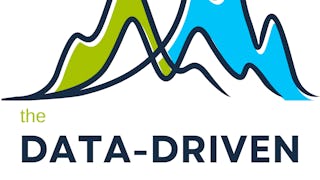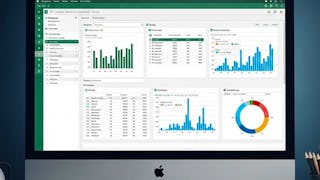- Browse
- Statistical Classification
Results for "statistical classification"

Skills you'll gain: Responsive Web Design, HTML and CSS, Web Design and Development, UI Components, Prompt Engineering, Web Development Tools, Web Development, Generative AI, Javascript, Software Engineering, Machine Learning
4.5·Rating, 4.5 out of 5 stars73 reviewsIntermediate · Guided Project · Less Than 2 Hours

Skills you'll gain: Financial Statement Analysis, Financial Analysis, Return On Investment, Profit and Loss (P&L) Management, Financial Modeling, Performance Metric, Accounting, Finance, Operating Expense, Investments
4.6·Rating, 4.6 out of 5 stars207 reviewsIntermediate · Guided Project · Less Than 2 Hours
 Status: Free TrialFree TrialU
Status: Free TrialFree TrialUUniversity of Colorado Boulder
Skills you'll gain: Data-Driven Decision-Making, Descriptive Statistics, Data Analysis, Probability Distribution, Statistical Software, Statistics, R (Software), Data Visualization, Statistical Analysis, Probability, R Programming, Probability & Statistics, Data Manipulation, Histogram, Taxonomy, Data Import/Export
4.3·Rating, 4.3 out of 5 stars12 reviewsBeginner · Course · 1 - 3 Months
 Status: Free TrialFree TrialR
Status: Free TrialFree TrialRRice University
Skills you'll gain: Probability & Statistics, Microsoft Excel, Descriptive Statistics, Business Analytics, Box Plots, Probability Distribution, Data Visualization, Probability, Statistics, Business Mathematics, Spreadsheet Software, Data-Driven Decision-Making, Algebra, Bayesian Statistics, Arithmetic, Case Studies, Statistical Analysis, Quantitative Research, Data Analysis, Correlation Analysis
4.7·Rating, 4.7 out of 5 stars15 reviewsBeginner · Course · 1 - 3 Months
 Status: NewNewStatus: Free TrialFree TrialK
Status: NewNewStatus: Free TrialFree TrialKKhalifa University
Skills you'll gain: Data Strategy, Model Deployment, Data Governance, Model Evaluation, Transfer Learning, Data Quality, Data-Driven Decision-Making, Business Leadership, Predictive Analytics, Machine Learning, Strategic Decision-Making, Artificial Intelligence, Large Language Modeling, Classification Algorithms, Regression Analysis, Decision Tree Learning
Beginner · Course · 1 - 3 Months
 Status: NewNewStatus: Free TrialFree Trial
Status: NewNewStatus: Free TrialFree TrialSkills you'll gain: Microsoft Excel, Pivot Tables And Charts, Excel Formulas, Spreadsheet Software, Business Reporting, Data Visualization, Excel Macros, Dashboard, Forecasting, Data Analysis, Data Visualization Software, Predictive Modeling, Data Validation, Productivity Software, Data Entry, Data Management, Financial Modeling, Data Security, Data Integrity, Computer Literacy
4.8·Rating, 4.8 out of 5 stars98 reviewsBeginner · Specialization · 1 - 3 Months
 Status: Free TrialFree TrialD
Status: Free TrialFree TrialDDuke University
Skills you'll gain: Data Visualization Software, Data Visualization, Data Storytelling, Statistical Visualization, Interactive Data Visualization, Plot (Graphics), Plotly, Matplotlib, Data Presentation, Dashboard, Seaborn, Tableau Software, Scatter Plots, Heat Maps, Histogram, Google Sheets, Data Analysis, Python Programming, Cloud Applications, Business Communication
4.2·Rating, 4.2 out of 5 stars25 reviewsIntermediate · Course · 1 - 4 Weeks
 Status: Free TrialFree TrialI
Status: Free TrialFree TrialIIESE Business School
Skills you'll gain: Financial Acumen, Financial Statements, Working Capital, Financial Analysis, Balance Sheet, Financial Management, Return On Investment, Forecasting, Profit and Loss (P&L) Management, Operational Analysis, Business Metrics, Cash Flow Forecasting, Financial Modeling, Accounts Receivable, Accounts Payable, Inventory Management, Business Strategy
4.9·Rating, 4.9 out of 5 stars402 reviewsBeginner · Course · 1 - 4 Weeks
 Status: Free TrialFree TrialU
Status: Free TrialFree TrialUUniversity of California, Santa Cruz
Skills you'll gain: Time Series Analysis and Forecasting, Forecasting, R Programming, Bayesian Statistics, Statistical Modeling, R (Software), Statistical Inference, Regression Analysis, Data Analysis, Mathematical Modeling, Probability Distribution
4.2·Rating, 4.2 out of 5 stars17 reviewsIntermediate · Course · 1 - 3 Months
 Status: NewNewStatus: PreviewPreviewI
Status: NewNewStatus: PreviewPreviewIIE Business School
Skills you'll gain: Critical Thinking, Logical Reasoning, Analytical Skills, Generative AI, Empathy, Cognitive flexibility, Research, Lifelong Learning, Data Analysis, Decision Making, Statistical Analysis
Beginner · Course · 1 - 4 Weeks

Skills you'll gain: Portfolio Risk, Portfolio Management, Risk Management, Financial Market, Financial Modeling, Investments, Correlation Analysis, Market Data, Return On Investment, Analysis, Statistics
4.5·Rating, 4.5 out of 5 stars290 reviewsIntermediate · Guided Project · Less Than 2 Hours
 Status: Free TrialFree TrialE
Status: Free TrialFree TrialEEDHEC Business School
Skills you'll gain: Text Mining, Network Analysis, Data Visualization Software, Machine Learning Methods, Unstructured Data, Predictive Modeling, Web Scraping, Social Network Analysis, Financial Statements, Financial Market, Financial Analysis, Investments, Financial Modeling, Asset Management, Python Programming, Data Analysis, Consumer Behaviour
4.4·Rating, 4.4 out of 5 stars236 reviewsIntermediate · Course · 1 - 4 Weeks
In summary, here are 10 of our most popular statistical classification courses
- Github CoPilot for Beginners: Write Software With AI: Coursera
- Profit Analysis using Economic Value Added: Coursera
- Defining, Describing, and Visualizing Data: University of Colorado Boulder
- Data Analysis for Managerial Decision-Making: Rice University
- AI for Executives: The Basics: Khalifa University
- Microsoft Excel Mastery: From Basics to Pro Skills: EDUCBA
- Data Visualization with Python: Duke University
- Finanzas para directivos: IESE Business School
- Bayesian Statistics: Time Series Analysis: University of California, Santa Cruz
- Beyond the Obvious: How to Think in the Age of Generative AI: IE Business School










